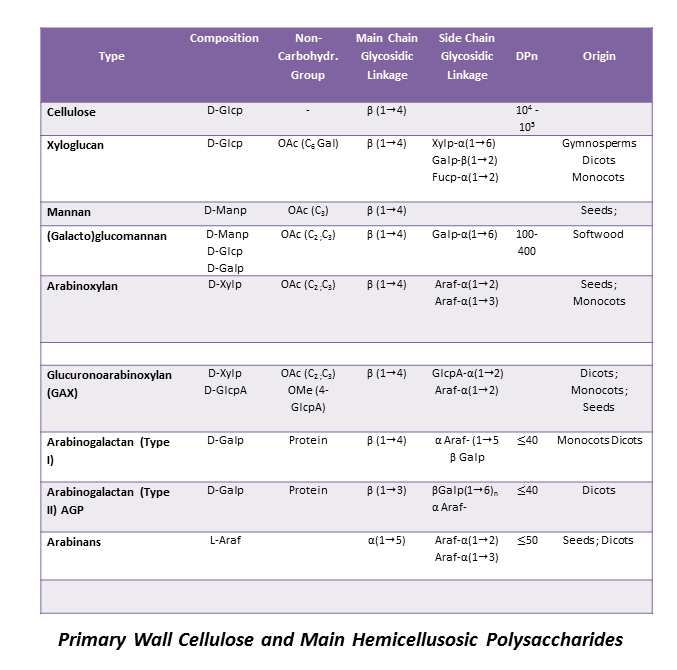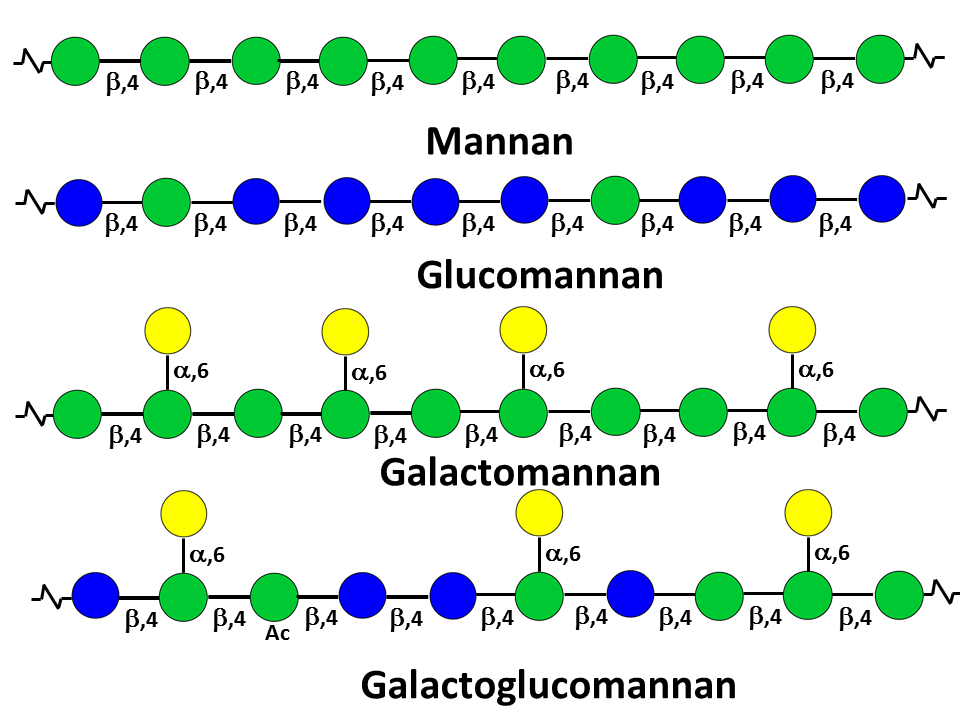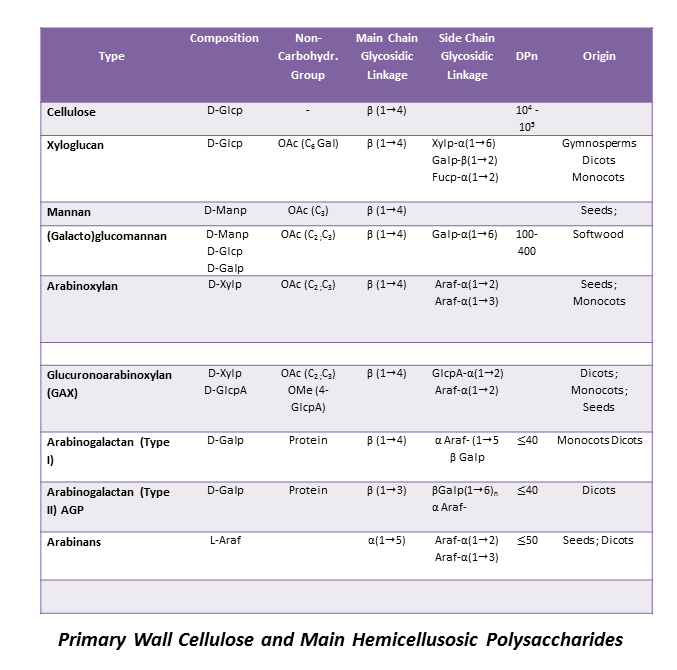Xyloglucan (XG)
They consist of a β-(1-4)-linked D-glucopyranosyl backbone carrying various side chains of D-xylopyranosyl-α-1-, D-galactopyranosyl-β-(1-2)-D-xylopyranosyl-α-1- , L-arabinofuranosyl-(1-2)-D-xylopyranosyl-α-1-, and (except in grasses) L-fucopyranosyl-α-(1-2)-D-galactopyranosyl-β-(1-2)-D-xylopyranosyl-α-1-.Fry 1989 The cellulose-like backbone is responsible for the strong and particular interaction between XGs and cellulose microfibrils. An interesting feature of this typical primary wall hemicellulose is that a certain regularity of distribution of the side chains constitutes repetitive subunits in its primary structure, the structure of which is denoted with a one-letter code.Fry et al 1993O’Neill &York 2003 XGs ’structures vary between plant species. Whereas terminal α-L-fucopyranosyl residues are present in the primary walls of a wide range of dicots, non-graminaceous monocots, and gymnosperms, in some other plant species, including solanaceae, fucose is rarely present and short arabinofuranosyl side chains are found. In spite of structural variability, XGs seem to be conserved in all plant species.Caffall & Mohnen 2009

The general role of XGs as the main load-bearing component between cellulose microfibrils has been recently questioned but they were confirmed to be implicated in primary wall mechanics.Park &Cosgrove 2012 In addition to their structural function in binding tightly to cellulose microfibrils via hydrogen bonds in a way that tethers them Fry 1989Hayashi 1989 XGs are the source of oligosaccharides mediated by the action of wall-bound xyloglucan endotransglycosylase (XET).These fragments have shown regulatory activities during plant cell growth and elongation McDougall, Fry 1989, suggesting that xyloglucan metabolism plays a role in the control of the elongation of plant cells.Takeda et al 2002
Glucuronoarabinoxylan (GAX)
This is the main type of the xylan family of hemicelluloses found in some primary walls. In grasses, and more generally the commelinid monocots, the glucuronoarabinoxylans (GAX) constitute the major hemicellulose Vogel 2008, representing about 20% of the primary walls, and exceed the proportion of XG. GAX has also been found in the primary walls of dicots (Arabidopsis, Darvill {et al} 1980. As members of the xylan group, primary wall GAXs possess the 1,4-linked β-D-xylopyranosyl backbone, which is branched by single α-D-glucopyranosyl uronic acid and α-L-arabinofuranosyl residues attached at position 2 and 3, respectively, to the β-(1-4)-D-xylopyranose backbone, which might also be acetylated at position 2 and/or 3. A particular feature of grass GAX is the esterification of arabinofuranosyl residues at O-5 by ferulic acid. Wende & Fry SC, 1997As a result, GAX in grass primary walls are covalently cross-linked via 5,5’-diferulate esters, and interact between cellulose microfibrils.Saulnier et al 1999
Mannan
They consist of a linear β-(1-4)-linked D-mannopyranosyl backbone. Mostly abundant in the endosperm of some seeds, these true mannans (main chain comprising only mannose) are only minor components of dicot plant primary walls, as shown in primary walls from Arabidopsis thaliana by the method of polysaccharide analysis using carbohydrate gel electrophoresis (PACE).Handford {et al} 2003

Glucomannan (GM) and (Galacto)glucomannan (GGM)
These types of mannose-containing hemicelluloses are often, and abusively, referred to as “mannan” in spite of the fact that their main chain consists of a backbone in which β-(1-4)-linked D-mannopyranosyl and D-glucopyranosyl residues are alternating, making them by definition true glucomannans. Mannose is generally predominating. GM is a minor polymer in the primary walls of dicots and grasses.
In GGMs, the mannose-glucose main chain is substituted by single-unit side chains of α-D-galactopyranose bonded to the main chain by (1-6)-bonds. Mainly the mannose units, but also some glucose units, may be substituted with galactose units. To the difference of the GGM found in the secondary walls of gymnosperms, where the ratio of galactose, glucose, and mannose are generally about 1:1:3, respectively, this ratio in dicot primary walls is closer to 1:1 between glucose and mannose with a variable lower proportion of galactose.Cartier {et al} 1988
Mixed-Linkage Glucans (MLG)
They have a linear backbone of glucose consisting of cellotriosyl and cellotetraosyl units, (i.e. β-(1-4)-linked D-glucopyranosyl residues) linked together by β-(1-3) linkages. The length of the β-(1-4)-linked segments may be more than 3 or 4 glucosyl residues. Absent from the dicots cell walls, the MLGs are a key distinguishing feature of the grasses in which they are distributed almost exclusively within the Poaceae.Fry {et al.,} 2008 Fincher 2009 In grasses the MGLs and GAXs replace the XGs and pectic polymers from dicots cell walls. They accumulate extensively in primary walls of coleoptiles during the elongation phase of growth, and undergo a turnover by a hydrolysis mechanism upon cessation of growth. However, they have been recently found in the secondary walls of mature stems of rice, suggesting that they may have a structural and mechanical role.Vega-Sanchez {et al} 2013

